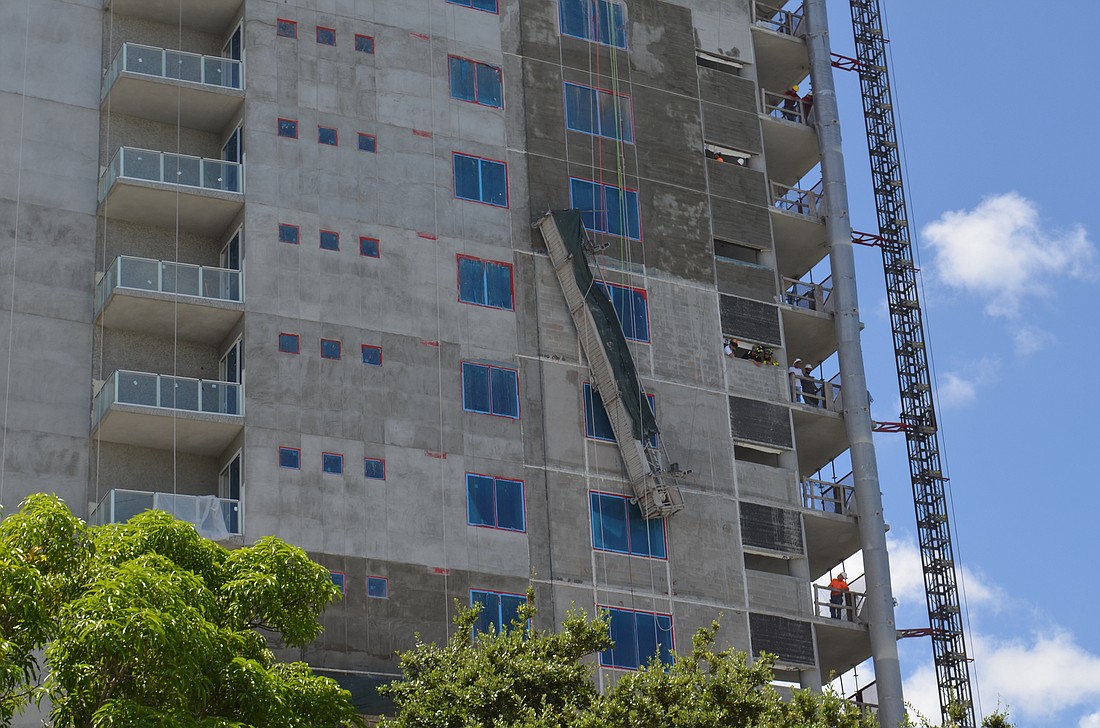- April 25, 2024
-
-
Loading

Loading

Increasingly removed from the effects of the 2007 recession that chilled construction investment in Sarasota, city leaders are considering the best strategies for dealing with an ongoing period of growth.
It’s an issue with many fronts. Residents have complained about issues associated with neighboring construction sites. Developers have criticized some city policies as burdensome. The city has invested more money in planning staff, hopeful to take a more forward-looking approach to guiding Sarasota’s evolution.
A new form-based zoning code is being developed, which will provide guidelines for what types of projects can be built throughout the city. Ahead of a citywide conversation regarding those proposed regulations, the community held several discussions examining growth.
In July, emergency personnel rescued a construction worker suspended on the side of a high-rise condominium project at 624 S. Palm Ave. The scaffolding malfunction was one of the highest-profile incidents at a downtown construction site this summer, but residents have called out cases of falling debris or other failures and asked the city to take action.
“The city has to consider the safety of all its residents,” said Lottie Varano, a resident of the Essex House condo on Palm Avenue. “That is its primary responsibility.”
Downtown builders have said such incidents are part of the process of construction in an urban setting. City Attorney Robert Fournier has said the city does not oversee disputes between private property owners.
Still, City Commissioner Jen Ahearn-Koch has signaled a desire to discuss ways the city could potentially mitigate the impacts of construction.
“It’s one of those things where you say to yourself, ‘How could this be happening?’ ” Ahearn-Koch said.
Residents and developers continue to search for a mutually acceptable compromise on another growth-related issue: tree preservation. In July, the city agreed to create a citizen Tree Advisory Committee, hoping a seven-person board could arrive at a tree ordinance that works for all parties involved. In August, however, the commission was split regarding the makeup of that board, with Ahearn-Koch expressing concern about the inclusion of development and Greater Sarasota Chamber of Commerce representatives.
On Monday, the city finally appointed members to the Tree Advisory Committee. The group will return to the commission with recommendations within a year of its first meeting.
In September, representatives for the citizen activist group STOP appeared at a debate regarding the city’s development review process. STOP, which formed in 2016 to advocate for changes to growth-related regulations in the city, continues to be a leading voice in the conversation surrounding development.
One of the group’s primary issues is administrative review, a process that allows city staff to approve a proposed project if it complies with the zoning code. Ahead of consideration of the new form-based code, STOP leaders are mounting a campaign against the expansion of administrative review and lobbying for more public involvement.
“What we think public hearings are going to give us are more compatible new buildings — buildings that can fit in better, live better with the existing neighbors,” STOP steering committee member Kate Lowman said.
Some members of the development community have stepped forward to challenge STOP’s assertions. Chris Gallagher, an urban designer with Hoyt Architects, held a six-week series of workshops on transportation beginning in October. He said the series was designed to “elevate the conversation” regarding another one of STOP’s main issues.
On both traffic and development, Gallagher said STOP had identified some relevant issues, but criticized their proposed solutions.
“Automobile congestion’s not fun for anyone,” Gallagher said. “We all agree on that. Let’s get to some things that are actually going to help mitigate, change, solve the problem of traffic.”
On Nov. 30, the City Commission is holding a special meeting to discuss the procedures for publicly reviewing the proposed form-based code. It marks the beginning of a crucial moment in the city’s approach to growth — and an opportunity to delve further into issues the community has shown it is eager to consider.